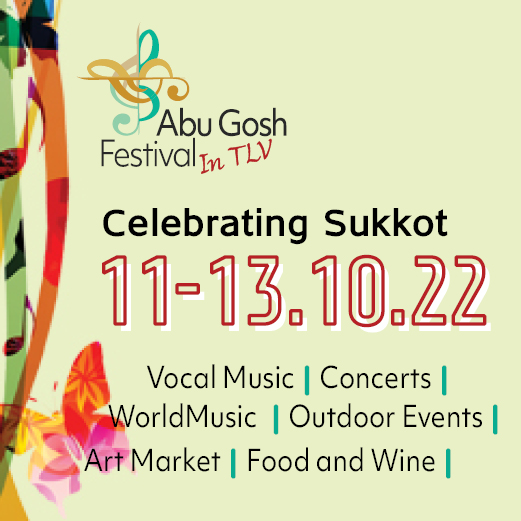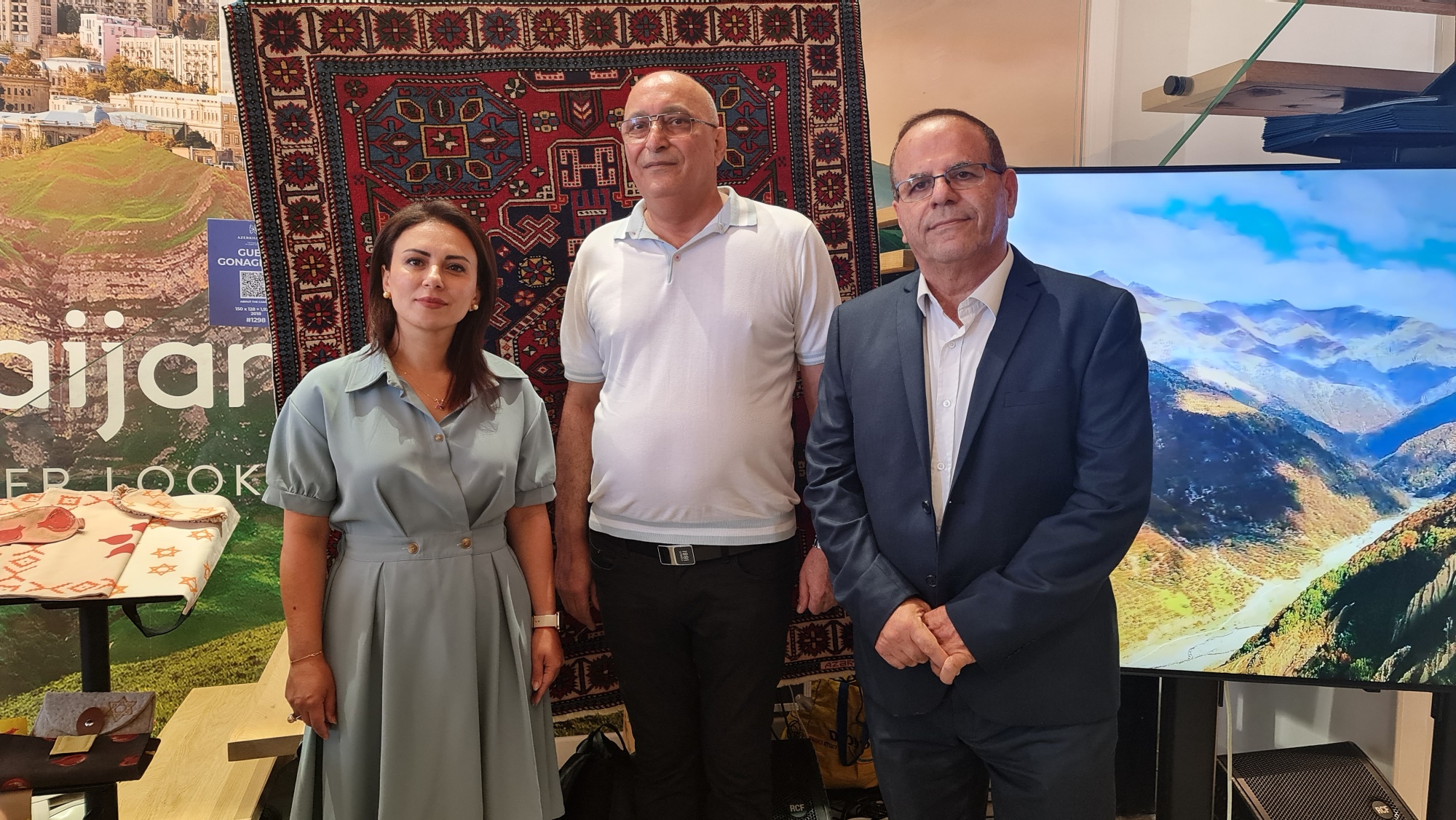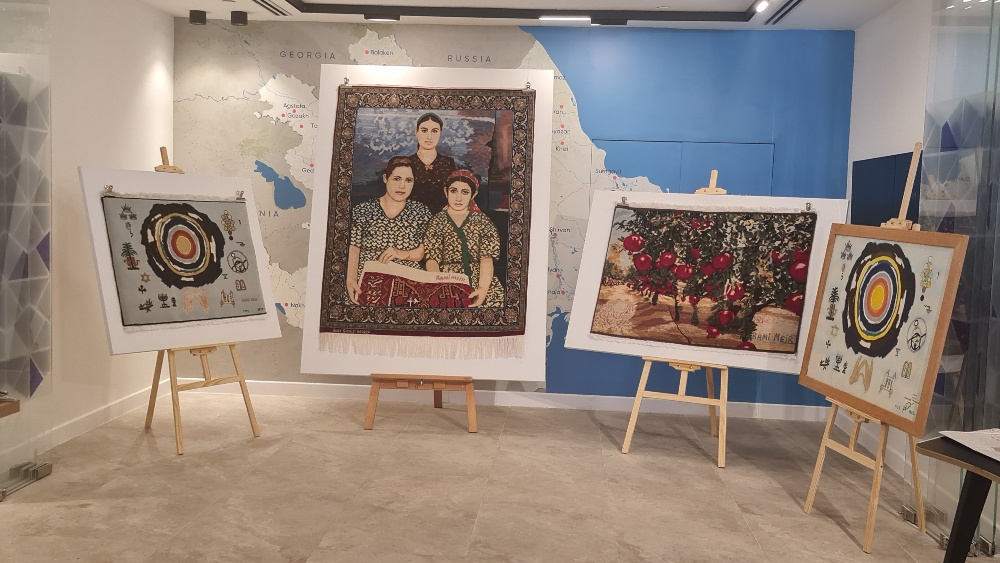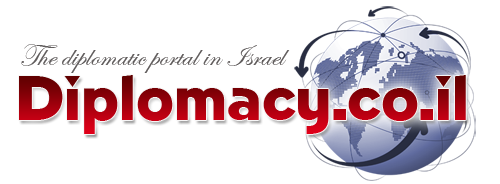Art & Culture
- Details
- Written by the Slovak Institute in Jerusalem

Exceptional Czech – Slovak exhibition of geometric abstraction will be presented in Jerusalem until the end of this year
Opening of the Czech – Slovak exhibition ‘ACID HAUS’ presenting two top-class geometric abstract artists – Ján Vasilko and Karel Štedrý attracted more than a hundred visitors.
On Thursday, September 1st, 2022, the Slovak Institute in Jerusalem hosted an opening of the Czech – Slovak exhibition of abstract art titled ‘ACID HAUS,’ presenting the established painters Ján Vasilko and Karel Štedrý.
Ján Vasilko (*1979) is a graduate of the contemporary art studio of doc. Adam Szentpétery at the Faculty of Arts of the Technical University in Košice. One of the most successful Slovak contemporary painters and a winner of many awards currently has his largest exhibition to date in the Eastern Slovakia Gallery in Košice.
Karel Štedrý (*1985) is a leading representative of the young generation of Czech painters. He is a graduate of the painting studio of Stanislav Diviš at the Academy of Arts, Architecture and Design in Prague. In 2010 he received the ARSkontakt prize for young visual artists. His work is characterized by the blending of apparent opposites – on one hand, that of architecture and classical modernism, and on the other hand of pop culture like graffiti, hip-hop, break-dance, and computer games.

Vladimír Beskid, curator of the exhibition: “This exhibition brings together two artists of the same generation, leading representatives of geometric abstraction in Slovakia and the Czech Republic, in an intense dialogue. In both cases, we can see a certain evaluation of the language of architecture and the visuality of modern art. Both painters are characterized by visual rhythm, order, and systematic composition. In defining the geometric abstract framework and the organized form of lines and surfaces, we find a vigorous dose of playfulness, variability, and dynamism in the visual language.”
Jakub Urik, the director of the Slovak Institute in Jerusalem: “I am glad that this exhibition was a success. I wanted to do an exhibition in Jerusalem, in cooperation with our Czech colleagues, especially because many Slovaks and Czechs living in Israel today remember their homes in Czechoslovakia. And also, because I know the works of both artists and I like the way they both perfectly complement each other in the form and color in their works. After I got the approval from the curator Vladimír Beskid and our Czech colleagues, we got straight to work.”
All those who could not attend the opening can still visit the exhibition at the Slovak Institute in
Jerusalem until January 5th, 2023.
- Details
- Written by Pamela Hickman

As in 2021, the upcoming Abu Ghosh Festival will once again be held in Tel Aviv, taking place from October 11th to 13th 2022. Popular from the 1950s as an annual event, the festival's organization was taken over in 1992 by music-lover Gershon Cohen and choral conductor Hanna Tzur, the revamped festival then happening twice a year. Attended by music-lovers from far and wide, people have been flocking to the two Abu Ghosh churches to hear the festival concerts, also enjoying the craft stalls, outdoor events and the relaxed, holiday atmosphere. As the Kiryat Yearim Church is presently undergoing renovation, the Sukkot Festival will take place at the Yitzhak Rabin Centre in Tel Aviv. The Rabin Centre, located on a hill, boasts commanding panoramic views of the Yarkon Park and of the city of Tel Aviv, with beautiful grounds and three concert venues – the Leah Rabin Hall, the Round Hall and the Triguboff Gardens nestling in the spectacular grounds. As of 2021, a new team has taken over the running of the festival, most of its members active on the Israeli music scene - Amit Tiefenbrunn - music director, Tessa Harari - management and production, Alon Harari - production coordinator and Yeela Avital - participation director and fundraising. The team has set its sights at creating a multi-sensory cultural experience with music at its core, providing listeners with events of diverse musical styles - western classical music, regional-, ethnic-, folk-, jazz- and classical Israeli music.
Here's a question: how do you prefer your concert program? Strictly classical? If so, you might like to attend Concert No.6: “Bach. Bach? Bach!”- the best of Bach’s Motets, Mass and Concerto for 2 flutes - featuring the Israeli Vocal Ensemble and the Barrocade Ensemble. Or Concert no.11: “Vivaldi - The Four Seasons/Mozart-Exultate Jubilate” with violinist Roi Shiloah and soprano Veronica Brook. Or two concerts introducing the festival's overseas guest choir - Concert no.12 “Motets and Madrigals-past to present'' and Concert no.15, “Shining Dreams'', both performed by Vocapella Limburg, an award-winning male choir from Belgium. In “Romantic Psalms”, Concert No.16, the Tel Aviv Chamber Choir and soloists, directed by Michael Shani, will present an all-Psalm program. "The Reign of Love - Rome and Venice’s Baroque Opera Grandeur” (Concert No.20) will offer festival-goers a glimpse into some 17th- and 18th century Italian aristocratic families, their composers and operas of the time.
But let's say the festival atmosphere tempts you to move “outside the box” and indulge in a little mixing of styles, you might just choose to hear “Mediterranean Sensuality” (Concert no.3), performed by the Mezzo Ensemble, an encounter between songs and dances of 17th century Europe and Greek music of the 20th century. “Carmen’s Jazz Vibe” (Concert No.4) promises a daring and electrifying program, in which soprano Daniela Skorka joins the Guy Mintus Trio. "La Folia" (Concert No.10) will present the concept of insanity as expressed in both early- and contemporary music. For this event, Inbar Solomon (recorders), Yizhar Karshon (harpsichord) and Amit Tiefenbrunn (viola da gamba) will be joined by choreographer/dancer Nirit Rakhbi. In a “Magical Mystery Tour” (Concert No.13), English Baroque music, Shakespearean music, early Celtic music and Italian opera will come together as performed by Sunita Stanislav (Scottish harp), Uri Schleifer (Irish fiddle), Genevieve Blanchard (Baroque flute) and soprano Yeela Avital.

Festival-goers can also choose from music of different countries and ethnic styles, from the toe-tapping music of Argentina in “Concertango - 100 Years of Tango from Gardell to Piazzolla" (Concert No.2) or traditional Celtic and Jewish music, gypsy rhythms and a touch of jazz improvisation, performed by the Tzalool Duo (Concert No.5). East meets west in an "Ethnic Celebration" (Concert No.7), a program that includes Bartok's "Romanian Folk Dances", but also Turkish, Armenian, and Israeli Music, as performed by the Galilee Ensemble. No new faces to Israeli audiences, members of the Hortus Musicus Ensemble (artistic director – Andres Mustonen) will take listeners on a whirlwind tour of the Balkans and the Orient. For those of us who are partial to American country music - getting a buzz from the songs of Bob Dylan, Hank Williams and Johnny Cash - the "Jacks of Diamond" players and vocalists will fit the bill with a "Folk, Bluegrass and Country Celebration" (Concert No.14). For people transported by the music of such greats as Mercedes Sosa, Dorival Caymmi, Villa-Lobos and Ariel Ramirez, Daniela Skorka and guitarist Eyal Leber will perform popular songs from Argentina, Brazil, Venezuela and Chile in “Latin-American Classics'' (Concert No,17). “Passion and Emotion” (Concert No.18), featuring singers Yasmin Levy and Yaniv D’Or with Ensemble Naya, will stir up emotions in an evening of Ladino and Spanish music, not to mention the wild, extreme sentiments of love, injustice, sadness and heartache to be experienced in “Fuego y Tierra” (Fire and Earth) (Concert No.19), a traditional Flamenco performance of song, guitar and dance.
And, no less important, festival-goers will have an opportunity to hear some of Israel's young, up-and-coming choral singers. Three of Israel's prominent youth choirs can be heard performing a wide variety of choral repertoire in “The Next Generation” (Concert No.8).
Winding up the 2022 Abu Ghosh Festival, the Rockberry Sisters, a unique all-female cover band, will indeed rock listeners into reliving the nostalgia of the “50’s and 60’s Greatest Hits” with songs of the Beatles, Aretha Franklin, The Monkeys, The Supremes, Elvis, The Beach Boys, and many more. The 2022 Abu Ghosh Festival also promises outdoor stalls selling up-market arts and crafts.
Ticket reservations: https://www.goshow.co.il/pages/minisite/234
Photo: Yoel Levi
http://pamelahickmansblog.blogspot.com
http://pamelahickmansmusicinterviews.blogspot.com
...
- Details
- Written by Tel Aviv Global

The Tel Aviv-Yafo Municipality, in collaboration with the Israeli Opera, is happy to continue its' annual tradition of hosting Opera in the Park!
This year they will perform the classic and beloved opera, Carmen, which tells the story of a gypsy whose life is filled with adventure, love, and surprise
TEL AVIV - On the 18th of August the Tel Aviv-Yafo Municipality, in collaboration with the Israeli Opera, will bring back its open performances tradition in the Ganei Yehoshua park, with a special production of "Carmen" by Georges Bizet, one of the most popular operas of all time.
The huge park productions that have been taking place there for over 20 years, attract tens of thousands of people every year who come to enjoy an exciting cultural experience, at no cost. Continuing on the tradition, the event will be hosted by Ron Huldai, Mayor of Tel Aviv-Yafo.
Ron Huldai, Mayor of Tel Aviv-Yafo: "This summer will be spent with a spectacular celebration of fierce love, abysmal hatred and burning passion. I am not referring to the election campaign that awaits us, but to the huge colorful production that is "Carmen" by Bizet, taking place on the wonderful stage of Opera in the Park. Similar to Carmen - the beautiful and warm-tempered gypsy, who broke the hearts of many suitors – is the Israeli Opera of Tel Aviv-Yafo: professional, rich in content and grace, mesmerizing in its beauty and voices and courted by its many suitors. I want to thank the Israeli Opera for their cooperation of over 20 years in producing "Opera in the Park", a production of the Tel Aviv-Yafo Municipality. The event takes place under the open sky and at no cost, and gives tens of thousands of culture and music lovers from all over the country a magical and unforgettable summer experience. You are all cordially invited!"
"Carmen" is a huge production with more than 250 participants on stage – soloists, opera choir, musicians, dancers, actors and a children's choir. At this moment in time, the enormous setting that is to be erected on the stage in Ganei Yehoshua is being built. Additionally, the opera seamstress is already working on preparing the hundreds of colorful and spectacular costumes intended for the performers.
The opera will be conducted by Dan Ettinger, music director of the Israeli Opera, directed by Gadi Shechter, who in previous years directed some of the productions that took place in the park, and accompanied by the opera orchestra – the Israel Symphony Orchestra Rishon LeZion and the Israeli Opera Choir.
The production in the park will be a summit meeting of two of Israel's biggest opera stars: Naama Goldman – who performed the role of Carmen for the first time in Masada and has been performing it with great success all over the world ever since, and soprano Ella Vasilevichky who will perform the role of Michaela.
"Carmen" by Georges Bizet, which premiered on March 3, 1875 at the Opéra-Comique in Paris, was a resounding failure in the eyes of audiences and critics. The burning failure struck to the depths of his heart, and exactly three months later he died. The greatest compliment given to this opera came from the philosopher Friedrich Nietzsche who said: "Music is wicked, refined and fantastic and at the same time extremely popular."
The opera "Carmen" is based on a novel by Prosper Mérimée and tells a story of love and passion, in which the soldier Don José was tempted to let Carmen, the free gypsy, escape from imprisonment. After Jose finishes serving his prison sentence, which he received because of helping Carmen, he joins her and her fellow gypsies and smugglers. When Carmen falls in love with bullfighter Escamio and is fed up with José, he is struck by a burst of jealousy. Carmen prefers to remain free and even die than to live with a man she does not love, and Don José's jealousy causes him to murder her.
Link for details about the event on the Tel Aviv-Yafo Municipality website Tel Aviv Travel Guide - Event Location (tel-aviv.gov.il)

Carmen at Ganei Yehoshua Park
Thursday |18.8.22| Gates open – 19:00| Start of show – 20:30
Conductor: Dan Ettinger
Director: Gadi Shechter
Set designer: Niv Manor
Choreographer: Neta Shezaf
Lighting designer: Eyal Levy Sharon
Sound designer: Yuval Silberstein
The Opera Orchestra – Rishon Lezion Symphony Orchestra
The Israeli Opera Choir
Young Bat Kol Choir
Soloists
Carmen: Naama Goldman
Don José: Leonardo Kaymi
Michaela: Ella Vasilevichky
Escamio: Oded Reich
Perskita: Tali Foam
Mercedes: Shai Bloch
Morales: Yair Polishuk
Zuniga: Noah Briger
Dankairo as Noam Heinz
Ramandado: Asheri Segev
Photo credit – Yossi Zwecker
ABOUT TEL AVIV GLOBAL & TOURISM
Tel Aviv Global & Tourism is a municipal company under the Mayor's Office. It facilitates the global quantum leap taken by the city of Tel Aviv-Yafo in creating economic and tourism growth.
- Details
- Written by Silvia G. Golan & Steven Aiello

The "Casa Brazil" initiative, organized by ApexBrasil in collaboration with the Brazilian Embassy in Israel, marks the 200th anniversary of Brazil's independence by highlighting Brazilian innovation, and the strong ties between Brazil and Israel, in a series of events held at the Tel Aviv port. As part of the celebration, 40 Brazilian companies from a wide variety of fields including food, beverages and agriculture, housing and construction, technology, digital games, fashion, etc. will present Brazilian innovation, design and culture to the Israeli market.
Casa Brazil is free and open to the public, with activities ranging from business meetings and lectures, to Brazilian jazz, Samba, Bossa nova, and other musical performances, Capoeira demonstrations, and culinary attractions from the best of Brazilian cuisine.
The Brazilian culinary events include cooking shows on Sunday September 4 at 19:00 , Monday September 5 at 14:00, Tuesday September 6 at 19:00, Wednesday September 7 at 20:00, Thursday, September 8 at 19:00, and on Friday, September 9 at 10:30.
Musical performances include Sunday, September 4 at 18:45 (Chorolê – Roda de Choro), Monday, September 5 at 19:30 (Brazilian Jazz and Bossa Nova), Tuesday, September 6 at 20:00 (Batucada), Thursday September 8 at 17:00 (Batacuda) and 19:30 (Roda de Forró). On Monday September 5 at 17:00 and Friday September 9 at 11:00 there will be capoeira shows. Tuesday, September 6 at 19:30 will feature a fashion show.
All activities will be held at Hangar 11, Tel Aviv port, from Sunday-Friday, September 4-9.
The full schedule can be seen here: https://preview.mailerlite.
- Details
- Written by Silvia G. Golan

When Art meets travel. Exclusive cocktail reception in honor of famous Azerbaijan -Israeli artist Rami Meir hosted by Azerbaijan Tourist Board & Azerkhalcha OJSC at the official representation in #telavivcity
Travel agents and representatives of the tourism industry attended a special event organized by the Israeli representative of Azerbaijan Tourist board in honor of the famous Azari-Israeli artist Rami Meir (Rahamim Migirov)
At the center of the event was a pop-up exhibition, co-organized with the national carpet project Azerkhalcha OJSC with four of his works carefully selected for the exhibition in Tel Aviv - original works turned into handmade rugs that reflect various aspects of Jewish life in Azerbaijan, symbols and elements.
"We are excited to host such a respected artist in Israel. Heritage, tradition and culture as well as authentic arts are some of the main factors that attract tourists, and in Azerbaijan there are all of these in abundance," said Jamila Talibazada, who runs the bureau in Israel.
"This is a country that loves Israel that radiates its love for all areas of life and I wish everyone success in deepening the tourist ties between the two countries."

Rami Meir is an Azerbaijani-Israeli artist born in Baku and originally from Netanya, who began to recreate in his paintings the history of his people, the mountain Jews of the Caucasus and the Trans-Caucasus. To his surprise his artwork caught the attention of critics and collectors around the world.
At the Photos: The host Mrs. Jamila Talibzade, Director of the ATB Israel, Former Minister @ayoobkara and the artist @ramimeirart
https://www.instagram.com/p/CgMIyG_j4nH/
Photos and video Silvia G Golan








